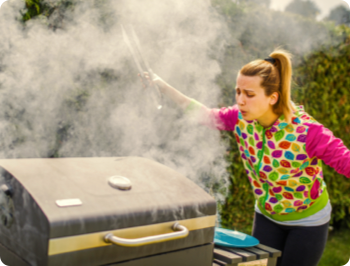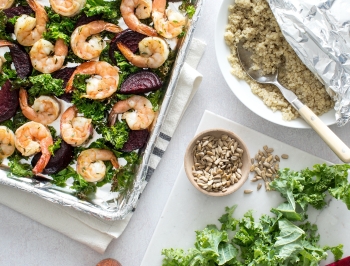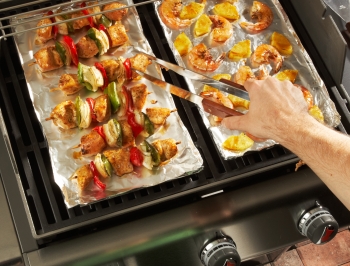How to Grill Burgers Like an Expert
Discover how to make burgers on the grill like a seasoned pro and explore our best grilled burger recipes.
Last updated: October 1, 2025
How to Prepare Hamburgers for the Grill
Get ready, grill masters (and wannabes!), because what’s to follow is your ticket to burger excellence. We'll explore the secrets of selecting the best ground meat, how to prep patties for the ultimate flavor and shape, and the benefits of using aluminum foil for grilling. So, grab your apron and fire up the grill—it’s burger grilling time!
SELECTING THE BEST GROUND BEEF FOR BURGERS
Most burger enthusiasts reach for tried-and-true ground chuck with a 20% fat content (80/20 ratio). Ground chuck is ideal for juicy but not greasy burgers.
If you want to elevate the taste and texture of your burgers, don’t be shy about mixing it up. Grilling pros and chefs recommend experimenting with other ground cuts of beef, such as brisket, boneless short rib, tri-tip, sirloin, and ground round. One famous chef swears by a blend of ½ pound ground beef short rib, ½ pound ground beef brisket, and 1 pound of ground chuck—all 80/20.
Tip: Some people opt to grind their own blend of meat. Ask your local butcher to grind your custom blend if you don't have a meat grinder.
CREATING BURGER BLENDS WITH OTHER MEATS
Lots of folks like to blend in other meats with their beef burgers. For instance:
- Ground pork: Ground pork is a popular choice for burgers due to its high-fat content, which adds richness to the burger.
- Ground chicken or turkey: These poultry options have a lower fat content and can be used to create lighter burger blends.
- Bacon: A blend of lean ground beef and bacon trimmings creates juicy and flavorful burgers. The bacon adds a smoky and savory taste to the patty without being overpowering.
HOW TO SHAPE HAMBURGER PATTIES
Most people are familiar with the traditional bun-size hamburger shape. However, there is no set rule for the number of ounces, the diameter, or the thickness of your burger. It depends on your preference for burger size. You can make anything from tasty handheld sliders to beefy ½-pound mega-sized burgers!
For classic-sized ¼-pound burgers, follow these instructions:
- Start with ¼ pound of burger meat
- Gently shape the burger with your hands or a ring mold
- Form patties that are ¾ inches to 1 inch thick and 3 inches to 4 inches in diameter
- Make a small dimple in the center to prevent puffing up while cooking
- Avoid overhandling the meat or compacting it too tightly to prevent a tough texture
- Lay your burger patty on a pan lined with a sheet of parchment paper or wax paper
- Once you've made your patties, pop them in the fridge for about 15 to 20 minutes. This will help them stick together better.
- If you prefer to freeze the burgers for later use, separate them with wax paper squares and wrap them in freezer paper. On the wrapping, jot down the preparation date and type of meat used for your burgers. This way, you'll know what you're defrosting later.
HOW TO SEASON BURGERS FOR GRILLING
There are two ways to season a burger: seasoning the burger blend before forming the patties or seasoning the patties after forming them. Burger cooks and chefs agree that seasoning after forming the patties is the way to go for the tastiest burgers. Why is that?
- Seasoning with salt before forming the patties can lead to a tougher, meatball-like texture, as the salt draws moisture out of the meat
- Seasoning the burger meat can lead to over-handling the beef, which also makes burgers tough
- Seasoning the patties with salt and pepper (or other grilling spices) just before grilling helps them adhere to the burger and gives it a satisfying, flavorful bite
Still, many cooks like to season the ground meat before they make the patties. To do this, gently stir in your spices, herbs, minced garlic, onions, or other mix-ins with a fork or your hands. Be careful not to overhandle or overseason the meat.
Tip: Do you want to test the seasoning level of your raw meat blend? Fry a little piece in a skillet to give the flavors a trial run.
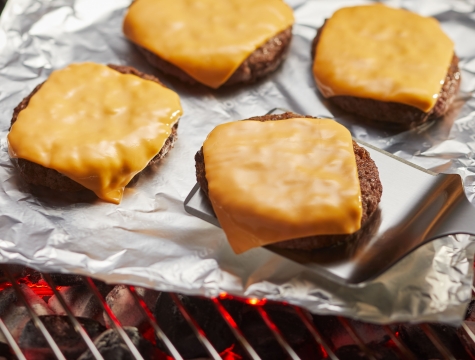
How to Make Burgers on the Grill
GRILL TEMPERATURE FOR BURGERS
Remember to clean your grill before preheating it. To clean your grill, you can use this quick hack with aluminum foil. Once your grill is clean, you should preheat your grill. The best burger cooking temperatures are between 375° and 400°F. For most gas grills, that means a medium-high to high heat setting. For a charcoal or gas grill, you can use a grill thermometer to ensure the temperature is optimal for burger grilling.
BURGER COOKING INSTRUCTIONS:
Cooking burgers on a grill is a great way to gather with family and friends and enjoy a delicious American favorite. Just keep an eye on your grill temperature to prevent overcooking. And follow our handy grilled burger tips to get the best results.
- Clean your grill.
- Preheat the grill to the recommended temperature of 375° to 400°F or medium-high to high heat on your grill setting.
- Grilled burger tips:
- Tear off a sheet of Reynolds Wrap® Grill Foil long enough to cover the grill grate. With a grilling fork, make drainage holes in the foil. Ensure that the dull, non-stick side is facing up.
- Place the burgers on the foil.
- To retain the juiciness of your burgers, it's best to flip them only once during cooking, about 5 minutes into the process. Avoid constantly moving or turning the burgers, which can dry out and toughen the meat. Additionally, don’t press down on the patty. This will squeeze out all the flavorful juices!
- You can achieve excellent results by combining open- and closed-lid cooking techniques. Start with the lid open for searing and then close it to finish cooking. This method can create a burger with a deliciously charred exterior and a perfectly cooked center.
- Checking for doneness: You should always use a meat thermometer to ensure meat is sufficiently cooked. Be sure to insert the thermometer through the side of the patty until the probe reaches the center. According to the USDA, the minimum safe temperature for ground beef burgers is 160°F. If your burger blend contains poultry, the minimum safe temperature for ground poultry is 165°F.
- Once the burgers are done, add cheese and toast burger buns.
- Remove from heat.
- Assemble and add your choice of toppings and burger condiments.
YOU'LL NEED...
Grill Foil

HOW LONG TO GRILL BURGERS
A ¼-pound burger, typically takes about 10 minutes to cook. According to USDA research, 1 out of every 4 hamburgers turns brown before it reaches a safe internal temperature. But the only safe way to know if burgers are "done" is to use a food thermometer to check they’ve reached minimum safe internal temperature or higher.
If your burger is smaller or larger, adjust the timing up or down, but always use a meat thermometer to check for doneness. Only flip your burgers once, about halfway through the cooking time.
Minimum safe internal temperatures for ground meats:
- Cook all raw ground beef, pork, lamb, and veal to an internal temperature of 160°F
- Cook all ground poultry to an internal temperature of 165°F
For food safety, the USDA states:
- NEVER partially grill burgers and finish cooking them later
- Always keep burgers HOT before serving, at least 140°F or warmer
- Chill your leftover burgers within 2 hours or sooner. If the temperature outside is above 90°F, you should chill within 1 hour. You can safely store fully cooked burgers in the refrigerator for 3 to 4 days and freeze them for up to 4 months
- When reheating fully cooked hamburgers, grill or reheat to 165°F or until steaming hot
GAS VS CHARCOAL GRILLS
Gas grills are convenient, offering you speed and ease of use. They heat up quickly, and the temperature is easy to control. Charcoal grills provide an authentic grilling experience and infuse your burgers with a smokier flavor. However, cooking perfect burgers over charcoal requires more effort and typically has a longer learning curve. It all comes down to personal preference.
Our Best Grilled Burger Recipes
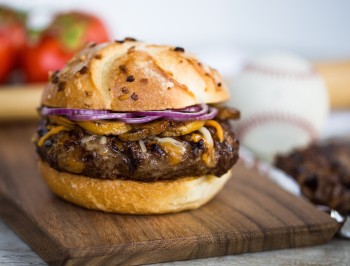
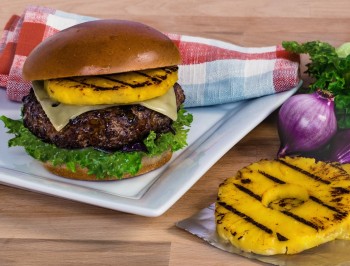
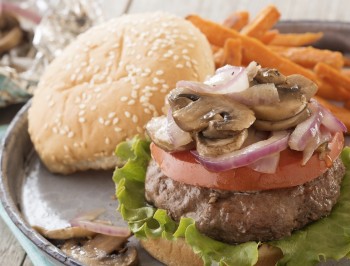
Frequently Asked Questions About Grilling Burgers
CAN YOU GRILL FROZEN BURGERS?
Yes, you can grill frozen burgers without thawing them first. According to the USDA, cooking frozen burgers will take about 50% longer. While it’s best to defrost meat before grilling for even cooking, frozen hamburger patties can be grilled without defrosting. Always use a food thermometer to check the meat temperature, especially in the center of burgers, to ensure safe cooking and doneness.
- Separate your frozen burger patties, removing any wax paper in between.
- Preheat your grill to a temperature of 325° to 375°F. Grilling slower at a lower temperature prevents the outside of the burger from overcooking while the inside stays frozen. Make sure the grill is fully heated before use.
- Tear off a sheet of Reynolds Wrap® Grill Foil long enough to cover the grill grate. With a grilling fork, make drainage holes in the foil. Ensure that the dull, non-stick side is facing up.
- Season the patties with salt and place the burgers on the foil.
- Remember, frozen patties will take 50% longer to cook. For a ¼-pound burger, it’s approximately 15 minutes.
- Flip the burgers about halfway through the cooking time, approximately 7 minutes.
- Grill for the remaining minutes until the burgers are cooked and reach an internal minimum temperature of 160°F for food safety.
HOW LONG TO GRILL BURGERS ON EACH SIDE?
For ¼-pound burgers, plan to grill them for at least 10 minutes, 5 minutes on each side. Remember, only flip the burger once. Use a meat thermometer to check if your burger is done. Insert it from the side and make sure it reaches the center. The minimum safe internal temperatures are 160°F for ground beef and 165°F for ground burgers with poultry. Depending on the size of your burgers, you may need to adjust the time.
HOW DO I MAKE BURGER PATTIES STICK TOGETHER?
There are several ways you can help burger patties stick together:
- Add a binding ingredient: Add egg yolks to your burger meat. This will hold the patties together better so they don't fall apart. Add an egg yolk per pound of meat, and you're good to go!
- Refrigerate patties: Chill them in the fridge for 15-20 minutes before placing them on the grill. This little trick will help them stick together better and firm up nicely.
- Avoid overhandling: Be gentle when shaping the patties to ensure your burgers don't turn out tough or fall apart. Don't pack them too tightly or handle them too much.
HOW LONG SHOULD YOU LET BURGERS SIT BEFORE GRILLING?
Once you've shaped your patties, stick them in the fridge for 15 to 20 minutes before throwing them on the grill. This will help your patties firm up and stick together better.
SHOULD I LEAVE THE GRILL LID OPEN OR CLOSED FOR BURGERS ON THE GRILL?
Cooking with both open- and closed-lid techniques makes perfect burgers. You can start with an open lid to sear the meat and then close it to complete the cooking process. This way, you can have a burger that's cooked just right, with a nicely charred outside and a juicy inside.
Related Articles:
